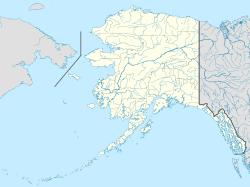Baranof Island facts for kids
|
Native name:
Sheet’-ká X'áat'l
|
|
|---|---|

Islands of the Pacific Northwest Coast
|
|
|
Location in Alaska
|
|
| Geography | |
| Location | ABC islands of Alaska |
| Coordinates | 56°57′05″N 134°56′52″W / 56.95139°N 134.94778°W |
| Archipelago | Alexander Archipelago |
| Area | 1,607 sq mi (4,160 km2) |
| Length | 100 mi (200 km) |
| Width | 30 mi (50 km) |
| Highest elevation | 5,390 ft (1,643 m) |
| Administration | |
|
United States
|
|
| State | Alaska |
| Demographics | |
| Population | 8532 (2000) |
| Pop. density | 2.05 /km2 (5.31 /sq mi) |
Baranof Island, also known as Baranov Island, Shee, or Sitka Island, is a large island in the northern Alexander Archipelago in Southeast Alaska. This area is part of the state of Alaska in the United States. The island was named in 1805 by a Russian naval captain, U. F. Lisianski, to honor Alexander Andreyevich Baranov. The native Tlingit people called it Sheet’-ká X'áat'l, or simply "Shee." It is the smallest of the ABC islands of Alaska.
Contents
Geography of Baranof Island
Baranof Island covers about 1,607 square miles (4,162 square kilometers). This makes it a bit larger than the state of Rhode Island. The island is about 105 miles (169 km) long and 30 miles (48 km) wide at its widest point. Its shoreline stretches for 617 miles (993 km).
Baranof Island is home to Peak 5390, which is the tallest mountain in the Alexander Archipelago. It is the eighth largest island in Alaska and the tenth largest in the United States. Most of the island is part of the Tongass National Forest, a huge national forest. A large section of the island is also a protected area called the South Baranof Wilderness. This means it is kept wild and untouched. A small bay called Ommaney Bay is located at the southern end of the island.
Communities on Baranof Island
In 2000, about 8,532 people lived on Baranof Island. Most of the island is part of the City and Borough of Sitka. Sitka is a city that also extends north onto Chichagof Island.
A very small part of Baranof Island, about 9.75 square kilometers (3.76 sq mi), is in the Petersburg Borough. This small area includes the town of Port Alexander. In 2000, 81 people lived there. Other towns on the eastern side of the island include Baranof Warm Springs, Port Armstrong, and Port Walter.
Goddard is a place south of Sitka that used to be a settlement but is now mostly abandoned. It has some private homes and natural hot springs with public bathhouses.
There are also five salmon hatcheries on the island that operate all year. These are places where young salmon are raised before being released into the wild. One is near Port Alexander, another near Baranof Warm Springs, two are in Sitka, and one is south of Sitka near Medvejie Lake.
The main jobs and businesses on Baranof Island are related to fishing, processing seafood, and tourism. The island is also known for its large brown bears and Sitka deer.
History of Baranof Island
The first European settlement on Baranof Island was started in 1799 by Alexander Andreyevich Baranov. He was the main manager and first governor of the Russian-American Company. This company was involved in fur trading. Baranof Island became the main center for Russian activities in North America from 1804 to 1867.
Around 1900, many small mining operations began on Baranof Island, especially near Sitka and Rodman Bay. Factories for canning fish, stations for whaling, and farms for raising foxes were also set up on Baranof Island and nearby smaller islands. However, most of these places were abandoned by the start of World War II. You can still see the remains of these old outposts today, though they are often in poor condition.
In 1924, the Alaska Territorial Game Commission moved mountain goats from near Juneau to Bear Mountain on Baranof Island.
A report in 1939, called the Slattery Report, suggested that new settlements could be created on the island through immigration. However, this plan was never put into action.
Baranof Island in Books
Baranof Island has appeared in several books:
- Louis L'Amour's novel Sitka tells a story about the conflict between Russian fur traders and American settlers.
- The island is an important setting in James A. Michener's novel Alaska, which covers many generations.
- The Yiddish Policemen's Union by Michael Chabon is a 2007 alternate-history novel. It imagines a Jewish territory in Sitka, including most of Baranof Island, based on the idea that the Slattery Report plan had actually happened.
- Local author John Straley has written several mystery novels that take place on and around Baranof Island.
- The Sea Runners, a 1982 novel by Ivan Doig, also features the island.
See also
 In Spanish: Isla de Baranof para niños
In Spanish: Isla de Baranof para niños


